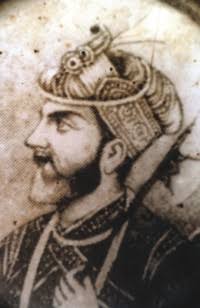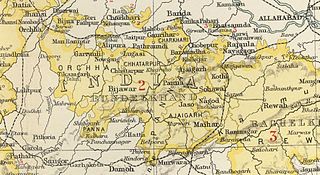| |||||
| Centuries: | |||||
|---|---|---|---|---|---|
| Decades: | |||||
| See also: | List of years in India Timeline of Indian history | ||||
The following lists events that happened during 1501 in India.
| |||||
| Centuries: | |||||
|---|---|---|---|---|---|
| Decades: | |||||
| See also: | List of years in India Timeline of Indian history | ||||
The following lists events that happened during 1501 in India.


The 16th century begins with the Julian year 1501 and ends with either the Julian or the Gregorian year 1600. The term is often used to refer to the 1500s, the century between January 1, 1500 and December 31, 1599.

The Deccan sultanates were five late-medieval Indian kingdoms—on the Deccan Plateau between the Krishna River and the Vindhya Range—that were ruled by Muslim dynasties: namely Ahmadnagar, Berar, Bidar, Bijapur, and Golconda. The sultanates had become independent during the break-up of the Bahmani Sultanate. In 1490, Ahmadnagar declared independence, followed by Bijapur and Berar in the same year. Golconda became independent in 1518, and Bidar in 1528.

Orchha is a town in Niwari district of Madhya Pradesh state, India. The town was established by Rudra Pratap Singh some time after 1501, as the seat of an eponymous former princely state of covering parts of central & north India, in the Bundelkhand region. Orchha lies on the Betwa River, 80 km from Tikamgarh & 15 km from Jhansi in Uttar Pradesh.

Nicolau Coelho was an expert Portuguese navigator and explorer during the age of discovery. He participated in the discovery of the route to India by Vasco da Gama where he commanded Berrio, the first caravel to return; was captain of a ship in the fleet headed by Pedro Álvares Cabral who landed in Brazil. He died at sea, possibly off the coast of Mozambique, while returning from India in the 5th Portuguese Armada with Francisco de Albuquerque.

Isa Khan was a Muslim Rajput chieftain who led the Baro Bhuiyans and a Zamindar of the Bhati region in 16th-century Bengal. Throughout his reign he resisted the Mughal empire invasion. It was only after his death that the region fell totally under Mughal control.

Tikamgarh is a town and a tehsil in Tikamgarh district in the Indian state of Madhya Pradesh. The city serves as a district headquarters. The earlier name of Tikamgarh was Tehri(i.e., a triangle) consisting of three hamlets, forming a rough triangle. In Tikamgarh town there is locality still known as 'Purani Tehri'. Until Indian independence in 1947, Tikamgarh, formerly called Tehri, was part of the kingdom of Orchha, which was founded in the 16th century by the Bundeli chief Rudra Pratap Singh, who became the first King of Orchha. In 1783 the capital of the state was moved to Tehri, about 40 miles (64 km) south of Orchha, which was home to the fort of Tikamgarh, and the town eventually took the name of the fort. The district is famous for the old fort of Kundar known as Garh Kundar, which was built by Khangars and remained the capital of kshatriya Khangar rulers from 1180 to 1347.

The Manikya dynasty was the ruling house of the Twipra Kingdom and later the princely Tripura State, what is now the Indian state of the same name. Ruling since the early 15th century, the dynasty at its height controlled a large swathe of the north-east of the Indian subcontinent. After coming under British influence, in 1761 they transitioned from feudal monarchs into rulers of a princely state, though the Manikyas maintain control of the region until 1949, when it ascended in union with India.

The Farooqi dynasty' was the ruling dynasty of the Khandesh sultanate from its inception in 1382 till its annexation by the Mughal emperor Akbar in 1601. The founder of the dynasty, Malik Ahmad participated in a rebellion against the Bahmani ruler Muhmmad Shah I in his early years. When he was compelled to flee from Deccan, he established in Thalner on the Tapti River. After receiving the grant of the fiefdoms of Thalner and Karanda from Firuz Shah Tughluq in 1370, he conquered the region around Thalner, which later became known as Khandesh. By 1382, he started ruling independently.
Rudra Pratap Singh Bundela was the founder and first raja of the kingdom that became the princely state of Orchha, India, during the British Raj era. His name is sometimes spelled Rudrapratap Singh and his last name, Bundela, is often omitted.

Orchha State was a kingdom situated in the Bundelkhand region and later a princely state in British India. It was located within what is now the state of Madhya Pradesh.

Pratapgarh was a medieval kingdom in the north-east of the Indian subcontinent. Composed of the present-day Indian district of Karimganj as well as parts of Tripura State and Sylhet, Bangladesh, the kingdom was ruled by a line of Muslim monarchs over a mixed population of Hindu and Islamic adherents. It was bordered by the larger kingdoms of Kachar, Tripura and Bengal.

The Greater Sylhet region predominantly includes the Sylhet Division in Bangladesh, and Karimganj district in Assam, India. The history of the Sylhet region begins with the existence of expanded commercial centres in the area that is now Sylhet City. Historically known as Srihatta and Shilhatta, it was ruled by the Buddhist and Hindu kingdoms of Harikela and Kamarupa before passing to the control of the Sena and Deva dynasties in the early medieval period. After the fall of these two Hindu principalities, the region became home to many more independent petty kingdoms such as Jaintia, Gour, Laur, and later Taraf, Pratapgarh, Jagannathpur, Chandrapur and Ita. After the Conquest of Sylhet in the 14th century, the region was absorbed into Shamsuddin Firoz Shah's independent principality based in Lakhnauti, Western Bengal. It was then successively ruled by the Muslim sultanates of Delhi and the Bengal Sultanate before collapsing into Muslim petty kingdoms, mostly ruled by Afghan chieftains, after the fall of the Karrani dynasty in 1576. Described as Bengal's Wild East, the Mughals struggled in defeating the chieftains of Sylhet. After the defeat of Khwaja Usman, their most formidable opponent, the area finally came under Mughal rule in 1612. Sylhet emerged as the Mughals' most significant imperial outpost in the east and its importance remained as such throughout the seventeenth century. After the Mughals, the British Empire ruled the region for over 150 years until the independence of India. There was a complete list of the different amils who governed Sylhet which was recorded in the office of the Qanungoh of Sylhet. However, most complete copies have been lost or destroyed. Dates from letters and seal traces show evidence that the amils were constantly changed. In 1947, when a referendum was held, Sylhet decided to join the Pakistani province of East Bengal. However, when the Radcliffe Line was drawn up, Karimganj district of Barak Valley was given to India by the commission after being pleaded by Abdul Matlib Mazumdar's delegation. Throughout the History of Sylhet, raids and invasions were also common from neighbouring kingdoms as well as tribes such as the Khasis and Kukis.
Pratap Manikya was a Maharaja of Tripura during the late 15th century.
Mukut Manikya was briefly the ruler of Tripura during the late 15th century.

Taraf, previously known as Tungachal, was a feudal territory of the Sylhet region in Bengal and was under many petty kingdoms in different periods of time. It was part of what is present-day Habiganj District in Bangladesh.